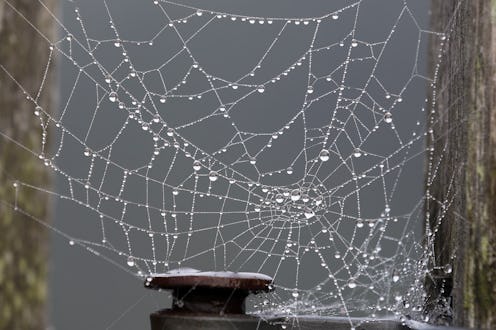News
A New Spider Species Was Just Discovered
Arachnophobes, look away, because this spider will do a handspring into your nightmares. Scientists have recently discovered the "flic-flac" spider in the Moroccan Sahara, reports The New York Times, and it can do flips like an eight-legged Gabby Douglas. Peter Jäger, a taxonomist at the Senckenberg Research Institute and Natural History Museum in Frankfurt, Germany, nicknamed the spider the flic-flac after the gymnastics move. Through morphological examination, Dr. Jäger has been able to identify the flic-flac as a new species.
Initially mistaken for a sister series inhabiting Tunisia and Algeria, the acrobatic spider has been identified as the Cebrennus rechenbergi after closely comparing the two species' copulatory organs. "However, the unique mode of locomotion also serves as a criterion to distinguish the species," Dr. Jäger explains in a Senckenberg Research Institute report.Like a gymnast, the Cebrennus rechenbergi creates a tumbling motion by propelling itself into the air, followed by a series of flic-flac movements with legs. This allows the spider to be highly flexible and capable of escaping harm, such as in the presence of a predator. Ingo Rechenberg, a bionics expert at the Technical University of Berlin, first spotted the spider in Morocco five years ago, and the leggy creature had quite a profound effect on him. When he witnessed its flic-flac movement for the first time, he began to cry. "It was sensational," he told the Times.
Whether you agree with Rechenberg or your first instinct is to take off your shoe and swat, this newly discovered spider is inarguably astounding. Here are four incredible — and incredibly terrifying — facts about the Cebrennus rechenbergi.
1. The spider doubles in speed when it flips, going from 3.3 feet per second when running to 6.6 seconds when tumbling.
From the New York Times' video on the arachnid:
<img alt="" src="http://lovelace-media.imgix.net/uploads/280/fa38f580-b76a-0131-6c64-52079bc90709.png?w=320" class="article-body-image"/>
<img alt="" src="http://lovelace-media.imgix.net/uploads/280/fa3e79a0-b76a-0131-bf4d-360cec5f68e3.png?w=320" class="article-body-image" title="Image: http://lovelace-media.imgix.net/uploads/280/fa3e79a0-b76a-0131-bf4d-360cec5f68e3.png?w=320"/>
<img alt="" src="http://lovelace-media.imgix.net/uploads/280/fa31dc90-b76a-0131-6734-521ded767216.png?w=320" class="article-body-image"/>
<img alt="" src="http://lovelace-media.imgix.net/uploads/280/fa335700-b76a-0131-06d7-4a9083b961fa.png?w=320" class="article-body-image"/>
<img alt="" src="http://lovelace-media.imgix.net/uploads/280/fa4aedd0-b76a-0131-c554-4eefffcb5f79.png?w=320" class="article-body-image"/>
<img alt="" src="http://lovelace-media.imgix.net/uploads/280/fa497760-b76a-0131-c557-4eefffcb5f79.png?w=320" class="article-body-image"/>
2. The flic-flac move consumes a lot of the spider's energy, and could have grave consequences.
Scientists believe the special movement is a last resort tactic, used only when needing to escape predators. "I can’t see any other reason," Dr. Jäger told the Times, adding: "It is a costly move. If it performs this five to 10 times within one day, then it dies."
3. The nocturnal Cebrennus rechenbergi lives in a tube-like structure it makes in the sand, covered by a sandy lid.
It emerges only at night to hunt for food. It was nighttime when Dr. Rechenberg first discovered the spider in Erg Chebbi, a sand desert in southeastern Morocco.
4. The tumbling spider was the inspiration for a robot.
Each year, Dr. Rechenberg goes to Morocco to study desert species and build robots based on their movements and behavior. He studies these species to "find out what the animals do to save energy." And he has now built a robot modeled after the flic-flac spider.
We'll give credit where it's due — the little critter helping to advance robotics technology is pretty impressive.
Images: New York Times
